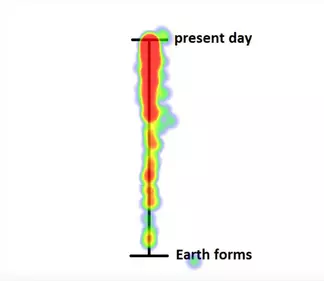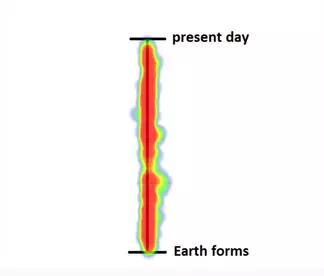Geologic Time
Summary
Formative assessment questions using a classroom response system ("clickers") can be used to reveal students' spatial understanding.
Students are shown this diagram and instructed to "Click on the line where humans appeared on Earth." A follow-up question instructs students to "Click on the line where dinosaurs appeared on Earth."
Context
Audience
Skills and concepts that students must have mastered
How the activity is situated in the course
Goals
Content/concepts goals for this activity
Higher order thinking skills goals for this activity
Skills goals for this activity
Description and Teaching Materials


Students use Top Hat technology to click on the location of their choice, given the blank geologic timeline diagram shown above. TopHat creates a "heat map" of student answers, as shown at right. Note that the two images at right show responses to two different questions: when did dinosaurs first appear on Earth and when did humans first appear on Earth. Both images show student responses prior to instruction. The instructor and students can see how well students, collectively, agree on the answer(s).
Science of Learning: Why It Works
There is accumulating evidence that engaging in spatial prediction and receiving feedback about the nature of one's errors leads to improved spatial reasoning (Gagnier et al. 2017; Resnick et al., 2017). Making a prediction, receiving feedback, and learning from the mismatch between the expected and actual outcomes is a process studied in cognitive science called the delta-rule model of learning (Rescorla and Wagner, 1972). Modern models of learning from the education research literature focuses on Piaget's concept of accommodation, where people will adjust their mental models as a consequence of the the feedback (Dole and Sinatra, 1998). Examples from research on geology concepts show us that students' build more scientifically accurate mental models after engaging in prediction and feedback. Gagnier et al. (2017) engaged students in making predictions about the interior of a geologic structure using block diagrams. The cycle of prediction and feedback facilitated students improved performance on a test of penetrative thinking. Resnick et al. (2017) engaged students in making predictions about the geologic time scale using a classroom response system (clickers). Students answered multiple-choice questions about the position of geologic events on a typical diagram of the geologic time scale. The spatial prediction clicker questions were as effective as, and more efficient than a hands-on meter stick activity at building a scientifically accurate linear conception of geologic time. Building on this research, we propose that the technique described here is a useful approach to identify students' spatial conceptions associated with various geologic phenomena (LaDue and Shipley, 2018).
Teaching Notes and Tips
Assessment
References and Resources
There are several systems that offer click-on-diagram questions. The one we use is https://tophat.com.
References
Beatty, I. D., & Gerace, W. J. (2009). Technology-enhanced formative assessment: A research-based pedagogy for teaching science with classroom response technology. Journal of Science Education and Technology, 18(2), 146-162.
Dole, J. A., & Sinatra, G. M. (1998). Reconceptalizing change in the cognitive construction of knowledge. Educational psychologist, 33(2-3), 109-128.
Gagnier, K. M., Atit, K., Ormand, C. J., & Shipley, T. F. (2017). Comprehending 3D diagrams: Sketching to support spatial reasoning. Topics in cognitive science, 9(4), 883-901.
LaDue, N.D. and Shipley, T.F. (2018). Click-on-Diagram Questions: A New Tool to Study Conceptions using Classroom Response Systems. Journal of Science Education and Technology, 27(6), 492-507.
Rescorla, R. A., & Wagner, A. R. (1972). A theory of Pavlovian conditioning: Variations in the effectiveness of reinforcement and nonreinforcement. Classical conditioning II: Current research and theory, 2, 64-99.
Resnick, I., Newcombe, N. S., & Shipley, T. F. (2017). Dealing with big numbers: Representation and understanding of magnitudes outside of human experience. Cognitive science, 41(4), 1020-1041.

![[creative commons]](/images/creativecommons_16.png)
